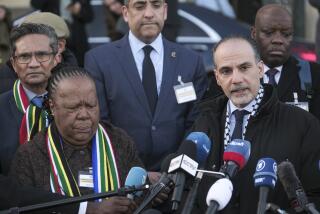South African Troops Launch New Drive Into Angola
- Share via
PRETORIA, South Africa — Troops invaded Angola on Monday in a preemptive South African strike against black nationalist guerrillas fighting for the independence of Namibia, military headquarters announced here.
Gen. Constand Viljoen, chief of the South African Defense Forces, said ground troops supported by planes and helicopters crossed into southern Angola in several places from Namibia (South-West Africa) in pursuit of a battalion of guerrillas from the South-West Africa People’s Organization (SWAPO).
Lt. Gen. Ian Gleason, the army chief of staff, said the operation will last several days and possibly a week until the guerrilla forces--the size of which he gave at 400 to 800 men--are destroyed or driven far back from the frontier.
Gleason refused to say how many South African soldiers are involved, but he seemed to be talking in terms of several battalions. Precise areas of attack also were not provided.
Heavy Weapons, Terrorism
According to South African intelligence, the guerrillas were about to mount a series of mortar and rocket attacks on military and civilian targets in northern Namibia from across the Angolan border. Other guerrillas were to be sent on terrorist missions to Namibia’s major towns, Viljoen said.
Angolan government troops were advised of the operation as it began, Viljoen said, and were warned not to interfere. So far, there have been no clashes between the Angolan and South African forces, the military chief said.
The attack violates the 1984 U.S.-brokered agreement between South Africa and Angola that calls for the total withdrawal of South African troops from Angola. Pretoria warned when it withdrew its last troops in April, a year later than it promised, that it would send them back if the SWAPO rebels resumed cross-border attacks into Namibia, and it has done so on at least four occasions in the last four months.
“In light of . . . irrefutable evidence of SWAPO’s plans directed at the inhabitants of South-West Africa and their contempt of repeated warnings to cease their violence, the security forces are left with no other alternative than to continue with this operation,” Viljoen said.
He said that two guerrillas recently captured in Namibia have admitted that they were part of a reconnaissance team planning attacks that South African intelligence had forecast for September and October. There has also been a recent sharp surge in sabotage, abductions and intimidation by guerrillas who infiltrated Ovamboland, the major border region of northern Namibia, Viljoen added.
Big Arms Cache
Police in the territory said earlier this month that they had seized more than half a ton of high explosives in Windhoek, the Namibian capital, and foiled what they said would have been the largest terror campaign mounted by the guerrillas.
The arms cache was the biggest to be seized in Namibia and included two auto tires packed with explosives that were to have been planted at the main post office and main hotel, according to the police.
The Namibian guerrillas have been fighting for nearly 20 years to end South African rule over the territory, a former German colony that Pretoria has administered since World War I. The South Africans have refused to leave despite repeated calls by the United Nations for Namibian independence. About 1 million people live in Namibia, 90% of them black or of mixed race.
In a smaller, two-day, cross-border raid at the end of June, South African forces struck about 30 miles into Angola, reportedly killing 57 people and capturing five. South African casualties were given as one dead and nine wounded.
Pretoria came under sharp international criticism for this operation, along with an earlier commando raid aimed at blowing up oil storage facilities in Cabinda and an attack on Gaborone, the capital of neighboring Botswana, where offices and homes of African National Congress representatives were hit and 12 people were killed.
With talks over Namibian independence stalemated and South Africa’s international isolation at a peak over its handling of domestic unrest, Pretoria apparently felt that it had little to lose in diplomatic terms from such an operation. Some South African officials suggested, in fact, that the attack would be “a good reminder to Luanda,” as one put it, “that it would be worth (Angola’s) while to develop better relations.”
More to Read
Sign up for Essential California
The most important California stories and recommendations in your inbox every morning.
You may occasionally receive promotional content from the Los Angeles Times.









